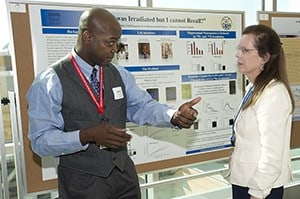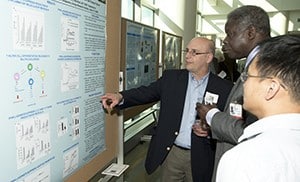Showcase Highlights UAMS Neuroscience Research
March 26, 2014 | The UAMS College of Medicine’s “Showcase of Medical Discoveries: A Focus on Neuroscience” on March 19 put the spotlight on the field of medical research that’s a top priority for the university and the nation. “It’s a key area we’re developing,” said Larry Cornett, Ph.D., UAMS vice chancellor for research. “Our development of it and the outstanding work faculty and graduate students are doing at UAMS are in keeping with direction from President Obama in regard to neuroscience.” In April 2013, the president announced the formation of the Brain Research through Advancing Innovative Neurotechnologies (BRAIN) Initiative, which he called a $100 million investment to give scientists the tools they need to get a dynamic picture of the brain and “better understand how we think, learn and remember.” Starting with the first showcase event in late 2012, the UAMS College of Medicine has sponsored the informal wine-and-cheese gatherings where the college’s research scientists discuss their findings with each other, donors and interested students and faculty. The college’s March neuroscience showcase was the sixth such event. “I think it’s a great idea to bring people together to discuss the research,” said Paul Drew, Ph.D., professor in the College of Medicine Department of Neurobiology and Developmental Sciences. “We try to interact with people on campus, but in reality, , this can prove difficult on a regular basis. Programs like the College of Medicine’s Showcase of Medical Discoveries, local meeting and research retreats really facilitate interactions between UAMS faculty members. That’s the excitement — to see what other people are doing and how you might collaborate.” Drew’s own research is looking at molecules called nuclear hormone receptors and the role they play in multiple sclerosis (MS). MS is an inflammatory autoimmune disorder that erodes the protective myelin around neurons. Drew said he and his research team have found one molecule, SR101, can suppress the activity of a cell important in causing MS. It doesn’t seem to suppress other autoimmune activity that is healthy and functional. One of the challenges in treating MS is that existing therapies tend to suppress healthy immune activity as well as MS-related activity, he said. Drew’s research, as well as research led by William Culp, M.D, College of Medicine professor of radiology and surgery, has been done in animal models. Drew and Culp both hope for additional funding for human trials. Culp said he hopes to know by the end of 2014 or early next year if his research will get the necessary government approvals and research money. Culp’s research team is examining whether nanodroplets of a drug called DDFPe could be effective in reducing brain damage from stroke by transporting oxygen to vulnerable tissue. Early findings are positive. If tried in humans, a first responder would administer the drug during the first 90 minutes in which a patient shows symptoms of stroke. “It does address the effects of stroke pretty dramatically,” Culp said. “We get rid of about 85 percent of the damage done to the brain in the first few hours.” Edgar Garcia-Rill, Ph.D., director of the Center for Translational Neuroscience (CTN), praised the research work of scientists like Drew, Culp and others on display in the 13 posters exhibited at the showcase. The CTN poster showcased research by Paige Beck, Ph.D., on a discovery of the mechanism of leptin action, by Mark Mennemeier, Ph.D., on a novel therapy for tinnitus, and by Charlotte Yates, Ph.D., on new treatments for spinal cord injury. The poster also showed how the Telemedicine Core Facility of the CTN, directed by Whit Hall, M.D., professor of neonatology in the UAMS College of Medicine, that runs the Pediatric Physician Learning and Collaborative Education (Peds PLACE) program has decreased newborn mortality across the state. “At the Southeast Regional IDeA meeting that UAMS hosted in November, the director of National Institute of General Medical Sciences, John Lorsch, went to the IDeA poster session,” Garcia-rill said. “He said our posters showed research which was competitive with research being done anywhere else in the country.” Posters at the showcase, using text and graphics, described the work of many different research project groups that include dozens of basic and clinical scientists as well as trainees. They were: · Nuclear Receptor Agonists: Potential Novel Therapies for Multiple Sclerosis. Researchers: Paul Drew, Jihong Xu, Janet Chavis, Gail Wagoner, James Douglas, Cindy Zhang-Gandhi, Michael Racke and Thomas Burris. · Novel Animal Models of Epilepsy for the Development of the Next-generation of Antiepileptic Drugs. Researchers: Fang Zheng, Kevin Phelan. · Fetal Alcohol Spectrum Disorders: Discovery of Neuroinflammation and Therapeutic Intervention. Researchers: Cynthia Kane, Kevin Phelan, Jennifer Johnson, James Douglas, Lihong Han, Gail Waggoner, Renea Smith, Paul Drew. · Ethanol Exposure and Cerebellar Development. Researchers: Dwight Pierce, Kim Edward Light, Abdallah Hayar, Xiong Lin. · Selective Control of Stem Cell Function in the Brain. Researchers: M.C. MacNicol, Angus MacNicol, C.E. Cragle, T.M. Montales, L.L. Hardy, Narsimha Penthala, V. Janganati, Michael Borreli, Rosalia Simmen, Peter Crooks, F. Cragle. · Does Diabetes Predispose One to Alzheimer’s Disease … or Vice Versa? Researchers: Steven Barger, Rachel Hendrix, Bounleut Phanavanh, Jordan Walters. · I Think I Was Irradiated but I Cannot Recall? Researcher: Antino Allen. · A Novel Therapeutic Target to Enhance Synaptic Plasticity in Alzheimer’s Disease. Researchers: Paul Gottschall, Matthew Howell, Michael Cozart, Brenda Gannon. · Human Myelin Proteolipid Protein Intron 1 Contains an Enhancer Essential for PLP1 Expression. Researchers: H. Hamdan, N.T. Kockara, S. Haun, P.A. Wight. · Neuroprotection in Acute Ischemic Stroke: the Beneficial Effects of Dodecafluoropentane Emulsion. Researchers: Stephen Nix, Sean Woods, Christine Arthur, Robert Skinner, Howard Hendrickson, Aliza Brown, John Lowery, Michael Borrelli, William Culp. · The Cognitive Connectome Project: Mapping the Neural Representation of Normative Variance in Cognition. Researchers: Andrew James, Tonisha Kearney-Ramos, Jennifer Gess, Jennifer Fausett, Clinton Kilts. · Paradoxical Effects of Serine Racemase Knockout in the G93A mSOD1 Mouse Model of Amyotrophic Lateral Sclerosis (ALS). Researchers: Misty Thompson, Ron Reed, Patrick Bennett, John Marecki Stephane Marinesco, Stephen Barger, John Crow. · Bringing Cures from the Bench to the Bedside, Center for Translational Neuroscience. Researchers: Paige Beck, Edgar Garcia-Rill, Whit Hall, Mark Mennemeier, Charlotte Yates. |


